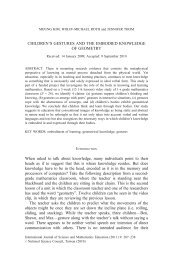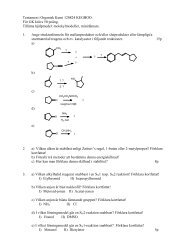TOOL FAILURES -CAUSES AND PREVENTION
TOOL FAILURES -CAUSES AND PREVENTION
TOOL FAILURES -CAUSES AND PREVENTION
You also want an ePaper? Increase the reach of your titles
YUMPU automatically turns print PDFs into web optimized ePapers that Google loves.
<strong>TOOL</strong> <strong>FAILURES</strong> -<strong>CAUSES</strong> <strong>AND</strong> <strong>PREVENTION</strong>I. JungDüsseldorf BöhlerV. LubichEdelstahlwerke Buderus AGWetzlarH.-J. WielandVerein Deutscher EisenhüttenleuteDüsseldorfAbstractThe aim of this project by the VDEh Subcommittee on Tool Steels is to documentthe various types of tool failure occurring from the design through to thetool application stages. Apart from systematically classifying these failuresaccording to type and occurrence, the project is intended to deliver practicalsolutions to the problems associated with the respective failure modes.Manufacturing defects, operating errors and unforeseen events all havean impact on tool service life. Heat treatment naturally plays a major roledue to its significant influence on the tool properties, and indeed most defectsappear after the heat treatment stage. Especially with some more recent heattreatment methods, remedial action is undoubtedly called for.To optimize the service life of a given tool, failures must be minimized inall manufacturing steps going into its production and its proper use must beensured. A register of tool failures covering the full range of failure sourcescan therefore contribute significantly to a tool service life improvement andhence, to more efficient manufacturing.1343
1344 6TH INTERNATIONAL <strong>TOOL</strong>ING CONFERENCEINTRODUCTIONThe present project was set up to record the numerous problems currentlyobserved in the heat treatment and use of tool steels, and to developappropriate suggestions and remedial strategies.Heat treatment problems are mostly attributable to a lack in structuraltoughness resulting in premature failure in the form of tool breakage/fracturing.This problem has several causes, one of which is the widespread conversionof virtually all heat treatment operations to vacuum-hardening technology.The previously common brine hardening method has become rare as a resultof environmental considerations. However, it had the advantage of permittingquenching at variable rates in oil, air, or water. With the vacuummethod, the quench rate lies somewhere between air and oil quenching, i.e.,it is slower than in the brine hardening process. In addition, quench ratesare now influenced significantly by the furnace load and hence, the degreeof furnace capacity utilization. This essential parameter, which eludes measurement,defines the quench rate in today’s applications.Several years ago, the exodus of toolmaking operations to low incomecountries began as part of corporate outsourcing strategies. Today, heattreatment operations in these countries are focused mostly on standard toolswhile the production of high performance products has mostly reverted towestern Europe. But premature tool failures due to defects (including heattreatment failures) are particularly critical in high performance tools pushingthe limits of achievable material properties. An optimized heat treatment canhelp greatly in these cases to make the performance potential of such highperformance tools fully accessible.The working group’s original subject was therefore extended to includeall tool failures currently observed, whether in toolmaking or downstreamoperating contexts. The aim was to systematically record and classify allfailures according to type and occurrence while offering solutions at the sametime. A key factor here is that many failure-causing tool defects will appearconspicuously often and over long periods after the introduction of newmanufacturing methods as the latter are becoming increasingly widespread(as was the case with spark-erosion methods a few years ago). Here we havethe opportunity to identify such systematic failures and to suggest remedialapproaches. A comprehensive description of all tool failures observed is ofspecial importance inasmuch as the performance of a given tool is determined
Tool Failures -Causes and Prevention 1345by numerous and diverse factors, from design through to the toolmaking,finishing and heat treatment stages and, ultimately, service conditions. Weare looking at a control loop in which all subordinate steps contribute tothe tool’s behaviour. To maximize service life, it is therefore importantthat each such subordinate step is performed in a virtually flawless manner.A Tool Failure Register of the type now being compiled should contributeeffectively to an improvement in tool service life.<strong>TOOL</strong> <strong>FAILURES</strong> <strong>AND</strong> THEIR SIGNIFICANCEOur understanding and prevention of tool failures must be viewed fromseveral perspectives:Prevention of economic loss toTool usersTool manufacturersSteelmakersSafety issues, i.e., the need to ensureOperating safetyLabour safetyEnvironmental safetyCompliance with quality assurance requirements, e.g., QS 9000Performance and service life improvementIncreased production reliability, since tool failures usually entail productiondisruptions up to the point of a production shutdown.The overall economic loss resulting from tool failures is significant, givenany analysis of tool failures from a business management viewpoint musttoday reflect the resulting processing and consequential costs, which usuallyamount to many times the costs of material. The service life improvementpotential is not yet factored into this equation. As a general estimate, itcan be stated that a 20 - 25% performance increase is achievable acrossall tools. In other words, the economic potential of many tools is far from
1346 6TH INTERNATIONAL <strong>TOOL</strong>ING CONFERENCEbeing adequately utilized. With manufacturing failures now being routinelytrackable to the source, the associated costs can be charged on all the wayto the liable party. Given the large number of different production stepsinvolved in toolmaking today, all companies contributing to the processare forced to furnish evidence of zero defect manufacturing. Under thisaspect too, a detailed understanding of tool failures and their prevention isan economic must.INFLUENCES ON <strong>TOOL</strong> SERVICE LIFEThe factors determining the service life of a tool may be viewed as acontrol loop starting with its design and ending with its use, Fig.1. As earlyas during the design stage, the tool’s essential load bearing capability is determinedvia shape and load rating calculations. At the materials level, asteel grade is selected and desired finish and working hardness are determined.Incorrect design specifications and an improper choice of materialswill usually result in tool breakage or deformation. At the manufacturingstage including machining and heat treatment, the design specifications arethen put into practice. Failures in this phase (and specifically heat treatmentfailures) will usually reduce the toughness of the tool, possibly resultingin tool failures due to breakage. In use, failures may occur as a result ofimproper handling, maintenance or repair practices, which likewise tend toresult in breakage.MOST FREQUENT <strong>TOOL</strong> FAILURE <strong>CAUSES</strong>If we classify tool failures according to the various failure causes, Fig.2,it emerges that these causes are essentially threefold. The highest frequencycan be found among manufacturing failures falling into the tool productioncycle (design, material, and execution defects), followed by operating errorsat the tool application stage (handling, maintenance and repair defects andconsequential effects). Unforeseen events (Force Majeure, exterior factors)are much rarer. Of all failures observed, defective material accounts for nomore than 5%. Execution (finishing) and heat treatment emerge as the mostcommon failure sources.
Tool Failures -Causes and Prevention 1347Figure 1.Influence on the life-cycle of a tool.INVESTIGATION OF <strong>TOOL</strong> <strong>FAILURES</strong>The investigation of tool failures comprises several stages. Starting withthe macroscopic analysis, cracks and fracture paths, pores and fracture surfacefeatures are evaluated. Chemical tests identify cases of incorrect materialidentity. Hardness testing is conducted to check for an adequate workinghardness or, where appropriate, hardness distribution. The main instrumentin tool failure analysis is the metallographic investigation, which determinesmaterial properties on the one hand (carbide distribution, cleanliness, grainsize) and material defects on the other (porosity, shrinkage holes, excessivesegregation, inclusions). Machining defects (grinding or erosion faults) arelikewise detected at this stage. The core element of any metallographic investigationis the inspection of the microstructure imparted by heat treatment(tempering condition, retained austenite, banding, coarseness and decarburization).
1348 6TH INTERNATIONAL <strong>TOOL</strong>ING CONFERENCEFigure 2.Classification of tool failures.THE <strong>TOOL</strong> FAILURE REGISTERCLASSIFICATION OF <strong>TOOL</strong> <strong>FAILURES</strong> BY DEFECTTYPESThe Tool Failure Register is classified according to the most commondefect types and their causes, Table 1. Due to the large number and diversityof failures encountered, we can merely give a selection of the currently mostcommon failure causes here. The results of the data collected to date showsthat fractures are by far the most dominant cause, accounting for 70% of alltool failures. Of the remaining failures, about 10% each were due to wear,cold weld/seizing phenomena and other causes.
Tool Failures -Causes and Prevention 1349SELECTED EXAMPLES OF <strong>TOOL</strong> <strong>FAILURES</strong>Design failures. One common design failure are sharp edged radii whichcause a pronounced notch effect when the tool is operated under load andmay cause it to break if its tensile strength is exceeded. An example ofsuch flawed design is illustrated in Fig.3. The product in question is a dieinsert made of a hardenable corrosion resistant high wear chromium alloydie steel (BÖHLER M 340). Cracking has occurred due to the high notchstress along the sharp edged radius. This might be remedied by providinga maximum radius in all load bearing areas. Another effective reduction ofthe radius notch effect can be achieved by polishing the radius surfaces. Ifthese measures should still not give an adequate fracture resistance, a toughermaterial must be used.Figure 3. Crack initiation at the sharp radius of a plastic mould die of a hardenablecorrosion resistance plastic mould steel.Material defects. Given today’s high levels of process reliability, materialdefects in steels sourced from technologically advanced countries havebecome rare. On the other hand, a large number of imported tool steels reachingthe Western Europe market does not always meet EN ISO 4957 materialquality standards. The number of internal and surface defects observed (e.g.,shrinkage holes, porosity, excessively decarburized surfaces, metalworking
1350 6TH INTERNATIONAL <strong>TOOL</strong>ING CONFERENCEcracks) has been on the increase again in recent years, as shown here for aHS6-5-2C (material No. 1.3343) steel bar in Fig.4. Material failures of thistype are found specifically in steels from CIS countries and emerging Asianmarkets. The damage caused by such material defects is particularly highsince they will usually entail substantial consequential costs, e.g., machiningcosts, production shutdowns, and the like. The loss to the overall economy isconsiderable, although the material costs of a contemporary tool will usuallyaccount for only 5% of the defect costs described.Figure 4. Forging failure at the outer surface of a round bar (253 mm Ø) of steel gradeHS6-5-2C (steel number 1.3343).Machining failures.Grinding failures. The following is an example of a grinding failure. Thetool in question is a forming roll made of BÖHLER K 340 (∼X110CrMoV8-2) hardened to 60 HRC, which failed shortly after commissioning. A metallographicsection through this roll shows a conspicuously bright area ofincreased hardness exhibiting a penetration depth of approx. 3 mm at the bottomof the profile in which a further secondary crack can be identified Fig.5a.Such rehardened zones consist of untempered brittle tetragonal martensitewhich is naturally susceptible to cracking. When the tool operates underload, incipient cracking may easily occur in this increased hardness area
Tool Failures -Causes and Prevention 1351and may propagate into the basic microstructure. The hardness distributionin a surface damaged by grinding is shown in Fig.5b; the excessive hardnessin the rehardened zone, the hardness drop in the underlying temperedzone and the subsequent hardness increase in the core structure are easilyidentifiable. These variations in structural conditions and hardness producean unfavourable internal stress distribution, mostly accompanied by tensilestress, which renders the surface sensitive to cracking. The intensity of suchstresses can be seen in Fig.5c: on this plate made of 90MnCrV8 steel (materialNo. 1.2842), high tensile stresses in the surface have caused a largearea to chip off and rise up several millimetres. The only way to preventmicrostructural damage during grinding is to provide adequate cooling. Itshould be noted here that in terms of cooling performance, today’s grindingemulsions with their increasingly high water content, a concession, interalia, to environmental concerns appear to be more inferior to emulsions withhigher oil content than has so far been assumed. The minimal lubricationprinciple widely adopted today additionally imposes higher heat loads onthe ground surface, thus increasing the risk of rehardening.Erosion failures. Erosion machining with excessive power inputs is anotherwidespread cause of failure. Especially with highly alloyed tool steels,excessive power levels may give rise to significant surface damage. Fig.6shows a metallographic specimen of the coarsely spark-eroded surface of ahigh alloyed cold work steel grade. The extensive melted zone, with incipientcracks due to thermal overloading, is clearly identifiable. Underneath itwe can see a rehardened zone consisting of brittle tetragonal martensite, asin the case of the grinding defect outlined above. The incipient cracks in themelted zone subject to tensile stress may easily propagate under load intothe brittle rehardened zone; they frequently extend along the carbide bands,as will be easily appreciated from Fig.6, and will ultimately cause the toolto fail. As with grinding failures, we can observe an uneven hardness distributionalong the eroded surface. Fig.6 illustrates the high hardness of themelted zone, the even greater hardness of the underlying rehardened area,the hardness drop in the underlying highly tempered area, and the followinggain in hardness toward the core microstructure. Here too these inhomogeneousstructures and hardness levels create an unfavourable internal stresssituation.
1352 6TH INTERNATIONAL <strong>TOOL</strong>ING CONFERENCE(a) Grinding crack with hardening zone in agrooved roll of high alloyed cold work tool steel(Etchant: 3 % HNO 3 ).(b) Variation in hardness within the hardeningzone of the grooved roll in Fig.5a.(c) Crack initiation during spark erosion due tohigh internal stresses, caused by grinding withoutsufficient cooling (hardened and temperedplate of steel grade 90MnCrV8 (steel number1.2842).Figure 5.This situation can be remedied by minimizing the power input into the toolduring spark erosion. Continuous erosion under fine machining conditions,at low current and high frequency, is preferable. Following the erosionprocess, the product should be tempered again at about 30 – 50 K below thelast tempering temperature to transform the rehardened zone into a tempered,tougher martensite. The melted zone should be mechanically abraded bygrinding, polishing or micro peening.The cracking phenomena frequently observed in erosion-machining ofhardened tool steels a few years ago due to internal stresses associated withlow tempering temperatures have become quite rare these days since mosttools are now subjected to secondary hardening prior to erosion and arelargely free from internal stresses due to their highly tempered state.
Tool Failures -Causes and Prevention 1353Figure 6. Spark eroded surface mit significant melting zone, new hardened zone andhigh tempered area of a high alloyed cold work tool steel. Microstructure and variation inhardness.Nitriding failures. Tool steels are nitrided to increase the wear resistanceof their surface. Another benefit of nitriding lies in the creation of subsurfacecompression stresses which protect against cracking. The increase in wearresistance is due to the penetration of nitrogen into the tool surface, althoughit must be said that with high alloyed tool steels, a "pile-up" of incomingnitrogen and the resulting formation of nitrides are a common risk. Suchnitrides will form mainly at the grain boundaries, where the nucleation energyis minimal and more space is available due to lattice deformation. Thesegrain boundary nitrides actually weaken the grain boundary, often to the pointwhere entire grains become dislocated from the lattice, Fig.7. With higheralloyed tool steels, care must therefore be taken to prevent excessive nitrogenconcentrations during nitriding. Optimum levels are easiest to achieve withplasma nitriding or fast acting nitriding solutions. Thus, nitriding is a processwhich yields high performance improvements when properly carried out, butmay just as easily shorten the tool life when improperly applied.Heat treatment failures.Quench stress cracking. Quench stress cracking is a stress relievingphenomenon produced by high thermal and transformation stresses, usually
1354 6TH INTERNATIONAL <strong>TOOL</strong>ING CONFERENCEFigure 7. Metallographical section through a overnitrided surface of a drawing die ofsteel grade X153CrMoV12 (steel number 1.2379) with significant nitride layers on the grainboundaries (Etchant: 3% HNO 3).during quenching from the hardening temperature. It is facilitated by anunfavourable tool geometry, such as uneven mass distributions with pronounceddifferences in cross section, the notch effect of sharp edged radii,etc. Fig.8 shows a die made of X38CrMoV5-1 (material No. 1.2343) whichis fairly large at450×195×800 mm; it was quenched and tempered to a workinghardness of 46 HRc, corresponding to 1500 MPa. The heat treatmentwas conducted in a shielding gas atmosphere, with subsequent quenchingin oil to room temperature. The quench stress crack shown here extendsalong a critical die contour with a sharp edged groove. Remedial measuresin this case would have to include an optimized design of the die contourfor the heat treatment, and a modification of the sharp edged groove. Toreduce thermal stresses between the edge and the core, a soak cycle duringthe cooling phase or an "interception" at 150℃ for subsequent temperingwould be recommended.Another quench crack is illustrated in Fig.9. The tool in this case is aforging die made of grade X38CrMoV5-1 steel (material number 1.2343)which exhibits an unfavourable mass distribution as well as some extremelythin walls in its contoured area. The quench crack originates in the thin wall
Tool Failures -Causes and Prevention 1355Figure 8. Stress relieved crack of a die casting die of steel grade X38CrMoV5-1 (steelnumber 1.2343) following a sharp edged groove.of the contour which, to make matters worse, is quite sharp edged. The resultingnotch effect, in conjunction with the high thermal stress encounteredin the quench, is responsible for the formation of this defect. Here, too, aremedial strategy would have to focus on an improvement of the tool contourthat eliminates sharp edged radii and major thickness differences. Soakingto relieve thermal stresses would be recommended.An unfavourable tempered microstructure may likewise give rise to quenchstress cracking. Fig.10 presents the coarse-grained tempered structure of analuminium die casting die made of 38NiCrMoV5-1 grade steel (material No.1.2343) with a working hardness of 45 HRc. This tool exhibited a quenchcrack after heat treating, indicating a low toughness of the coarse-grainedsuperheated structure. The die was heat treated at 1020℃ with subsequenthot quenching at 180℃. It should be noted that in this case, no stress relievingwas performed after the coarse machining step. The internal stressesintroduced by the machining cycle thus further facilitated the formation ofcracks. Remedial measures would have to include stress relieving at about650℃ after the machining step, a reduction of the heat treatment temperatureto 1000℃, and the adoption of hot quenching at 550℃ to reduce the risk ofquench stress cracking.Below we shall be looking at a number of typical heat treatment failureswhich are associated with unfavourable microstructures and reduced
1356 6TH INTERNATIONAL <strong>TOOL</strong>ING CONFERENCEFigure 9.Stress relieving crack of a forging die with extreme varying cross sections.toughness levels and may therefore result in cracking, spalling and fracturefailures.Figure 10. Coarse martensitic quenched and tempered structure of a die casting die ofsteel grade X38CrMoV5-1 (steel number 1.2343) (Etchant: 3% HNO 3).
Tool Failures -Causes and Prevention 1357Retained austenite. Elevated levels of retained austenite will usually resultin tool breakage after very short service periods and is currently one ofthe main failure causes in tools made of cold work and high speed steels withcarbon concentrations exceeding 0.8% by weight. Retained austenite problemshave become particularly common with the widespread changeoverfrom brine hardening processes with subsequent oil quenching to the morerecent vacuum hardening technology with its lower quench rates. Dependingon the furnace load situation, the quench rates in vacuum hardening varybetween those typical of oil and air quenching and those achieved with slowcooling under ambient air conditions. Classic oil hardening steels such ashot work tool steels or high speed steels will often fail to reach the necessarythrough hardening quench rate, especially if the product is fairly large sized.Fig.11 shows the coarse grained martensitic tempered structure of a coldforming die (140 mm diameter) made of X155CrVMo12-1 steel (materialNo. 1.2379). At 30%, the retained austenite level in this tool is quite significant.The failure of this die occurred soon after it was commissioned;it fractured along its interior radius. The hardness of this structure is 61HRC, it was heat treated under vacuum (5 bar) at 1040℃ with two temperingcycles at 540℃. The hardening and tempering steps were performed aspart of a single cycle under vacuum. The root cause of the failure in thiscase was the high portion of retained austenite which was apparently able tostabilize due to a too slow passage through the martensite stage; moreover,the tool was not allowed to cool down to a sufficiently low temperature afterthe hardening process and between tempering cycles. To achieve a fullmartensitic transformation, the quench rate would have to be increased byraising the gas pressure and adopting a more loosely spaced furnace loadenvelope. After the hardening process and between tempering steps, theproduct should be allowed to cool down to room temperature to enforce thefullest possible martensitic transformation, particularly after the hardeningstep. Experience has shown that a common hardening and tempering cycleunder vacuum does not favour the achievement of a full martensitic transformation.For economic reasons, the cooling phase after the hardening stepand between tempering steps is often set too short; the furnace is frequentlyfired up for tempering again as soon as the product has cooled to 50 - 70℃.However, in vacuum hardening the product should ideally be quenched toroom temperature as quickly as possible. Unlike the oil quenching processfollowing brine hardening, in which the tools are transferred to a tempering
1358 6TH INTERNATIONAL <strong>TOOL</strong>ING CONFERENCEfurnace to prevent cracking by reheating to about 70℃, vacuum hardeningitself entails no cracking risk since the process passes through the martensitestage much more slowly. As a result, the tool should be quenched toroom temperature to achieve the fullest possible degree of martensitic transformation.If the martensite stage is passed too slowly and the tool cannotcool down far enough, stabilized retained austenite will remain present. Ittransforms but sluggishly and incompletely during the subsequent temperingstage, particularly if the tool is not allowed to cool to room temperatureafter the tempering cycles. The tendency for retained austenite to stabilizewill become more acute with large tool dimensions and/or full furnace loads.With all tools made of cold work or high speed steels, which are expected toexhibit maximum toughness and high hardness at the same time, care shouldtherefore be taken to provide maximum quench rates and a generous furnaceload spacing. In the case of large hot work tools such as casting dies, anincreased cracking risk lies in the high thermal stresses between the edgeand the core, so that a hot bath soak cycle at about 500℃ is recommended.Figure 11. Martensitic hardening structure of a cold work die with large amounts ofretained austenite (Etchant: 3% HNO 3).Another structural state often associated with an elevated cracking riskis inadequately tempered martensite. Its presence may be attributable toan insufficiently high tempering temperature, or to incomplete temperingat higher temperatures. Fig.12 shows such a microstructure in a hob cutter
Tool Failures -Causes and Prevention 1359made of HS6-5-2-5 steel (material No. 1.3243) and hardened to 66 HRC.This tool failed through premature tooth breakout. A large portion of inadequatelytempered, only marginally stress relieved martensite is evident asa brighter structural area, particularly in the inner grain regions. On principlethis deficient tempering state reflects the same mechanisms as the highretained austenite levels discussed above. But in this structure the retainedaustenite has already been transformed to martensite, part of which will bepresent in a sufficiently tempered state after the last tempering step. Dueto the high portion of insufficiently tempered martensite, a microstructureof this type is extremely susceptible to fracturing, particularly at hardnessesexceeding 60 HRC.Figure 12. Martensitic hardening structure of a hob of steel grade HS6-5-2-5 (steel number1.3243) with insufficient tempered martensitic structure (Etchant: 3% HNO 3.)Grain boundary carbides. A reduced toughness in high alloyed toolsteels will also be observed with microstructures of the type illustrated inFig.13. The picture shows a 40 × 40 × 20 mm 3 stamping tool made ofX153CrMoV12 grade steel (material No. 1.2379), quenched and temperedto 61 HRC, which fractured soon after its first use. The heat treated structureconsists of an inadequately tempered martensite which additionally exhibitscarbide banding along the grain boundaries. This pattern reflects too slowcooling in the proeutectoid carbide precipitation range between 800 and600℃. Such carbide precipitation reduces the toughness of the material inthe grain boundary areas and will often result in intergranular fracturing
1360 6TH INTERNATIONAL <strong>TOOL</strong>ING CONFERENCEunder load. No handy remedy exists in this case, since the grain boundarycarbides are virtually impossible to remove even by renewed heat treatment.Figure 13. Low tempered hardening structure of a blanking tool of steel gradeX153CrMoV12 (steel number 1.2379; D2-type) with carbides, layered on the grain boundaries(Etchant: 3% HNO 3).SUMMARYThe examples presented can illustrate only a small portion of the casesdocumented in the failure register. However, they were selected with a viewto highlighting currently topical failure modes - specifically heat treatmentfailures of the type now regularly degrading tool performance.At the machining level, overheating during grinding operations as a resultof reduced cooling (water based grinding emulsions, minimal lubrication)are more frequent today. In erosion machining, fusion zones resulting fromcoarse erosion finishing are often a source of tool failure. Among heat treatmentdefects, quench stress cracking deserves to be mentioned although itoccurs more frequently in large hot work tools and is largely due to design.In tools made of high alloyed cold work and high speed steels, high retainedaustenite levels and insufficiently tempered martensitic hardening structuresare a cause of concern; these phenomena often occur in conjunction withcarbide precipitation along the grain boundaries which usually reflects an
Tool Failures -Causes and Prevention 1361insufficient quench rate in vacuum hardening processes and inadequate coolingbetween tempering phases. Such microstructures will often form duringcommon hardening and tempering cycles in a vacuum hardening furnacewhen the furnace is charged to full capacity. The economic benefits gainedby this process should therefore be carefully weighed against the existingtool failure risks.As is evident from these examples, newly launched manufacturing methods(such as grinding with minimum lubrication, erosion-machining or vacuumhardening) will usually give rise to new problems which may initiallyhave a detrimental effect on tool performance. An analysis of these casesand the resulting findings are indispensable for making the often significantpotential of these new manufacturing methods fully accessible throughimplementation of appropriate optimizing steps.ACKNOWLEDGMENTSWe thank the following companies for their input to this publication:BÖHLER, Düsseldorf, Edelstahlwerke Buderus AG, Wetzlar; Edelstahl Witten-Krefeld GmbH; Schmidt + Clemens GmbH + Co and Lindlar.
1362 6TH INTERNATIONAL <strong>TOOL</strong>ING CONFERENCETable 1.Classification of sorts and causes of failures within the Tool Failures Register1 sorts of failures(a) fracture / shelly spots(b) wear(c) cold weld / seizing2 failure causes(a) design failuresi forming failures / dimensioningii wrong choice of materialiii wrong working hardness(b) defects in materiali pores, shrink hole, cracks, strange inclusionsii distribution of carbidesiii undue segregations(c) machining failuresi bad surface quality (notch effect)ii damages on surface (grinding failures, erosion failures)iii welding defects (joint welding, deposit welding)iv nitriding failuresv missing stress relievingvi distortion(d) heat treatment failuresi quench stress crackii decarburizationiii retained austeniteiv insufficient tempering stagev coarse grain/mixed grainvi superheatingvii precipitations on grain boundary(e) handling failuresi mechanical overstressingii thermal overstressingiii corrosive overstressing
















